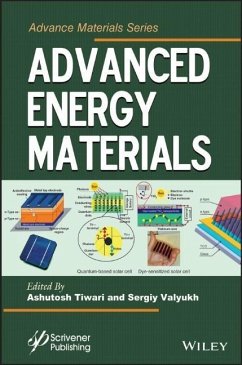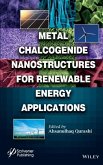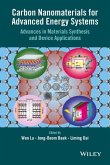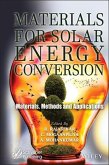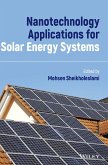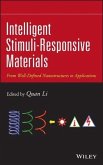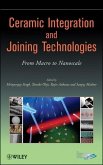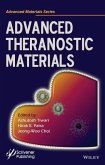Advanced Energy Materials
Herausgegeben von Valyukh, Sergiy
Advanced Energy Materials
Herausgegeben von Valyukh, Sergiy
- Gebundenes Buch
- Merkliste
- Auf die Merkliste
- Bewerten Bewerten
- Teilen
- Produkt teilen
- Produkterinnerung
- Produkterinnerung
An essential resource for scientists designing new energy materials for the vast landscape of solar energy conversion as well as materials processing and characterization
Based on the new and fundamental research on novel energy materials with tailor-made photonic properties, the role of materials engineering has been to provide much needed support in the development of photovoltaic devices. Advanced Energy Materials offers a unique, state-of-the-art look at the new world of novel energy materials science, shedding light on the subject's vast multi-disciplinary approach
The book focuses…mehr
Andere Kunden interessierten sich auch für
![Metal Chalcogenide Nanostructures for Renewable Energy Applications Metal Chalcogenide Nanostructures for Renewable Energy Applications]() Metal Chalcogenide Nanostructures for Renewable Energy Applications214,99 €
Metal Chalcogenide Nanostructures for Renewable Energy Applications214,99 €![Carbon Nanomaterials for Advanced Energy Systems Carbon Nanomaterials for Advanced Energy Systems]() Carbon Nanomaterials for Advanced Energy Systems162,99 €
Carbon Nanomaterials for Advanced Energy Systems162,99 €![Materials for Solar Energy Conversion Materials for Solar Energy Conversion]() Materials for Solar Energy Conversion232,99 €
Materials for Solar Energy Conversion232,99 €![Nanotechnology Applications for Solar Energy Systems Nanotechnology Applications for Solar Energy Systems]() Nanotechnology Applications for Solar Energy Systems226,99 €
Nanotechnology Applications for Solar Energy Systems226,99 €![Intelligent Stimuli-Responsive Materials Intelligent Stimuli-Responsive Materials]() Intelligent Stimuli-Responsive Materials201,99 €
Intelligent Stimuli-Responsive Materials201,99 €![Ceramic Integration and Joining Technologies Ceramic Integration and Joining Technologies]() Ceramic Integration and Joining Technologies214,99 €
Ceramic Integration and Joining Technologies214,99 €![Advanced Theranostic Materials Advanced Theranostic Materials]() Ashutosh TiwariAdvanced Theranostic Materials216,99 €
Ashutosh TiwariAdvanced Theranostic Materials216,99 €-
-
-
An essential resource for scientists designing new energy materials for the vast landscape of solar energy conversion as well as materials processing and characterization
Based on the new and fundamental research on novel energy materials with tailor-made photonic properties, the role of materials engineering has been to provide much needed support in the development of photovoltaic devices. Advanced Energy Materials offers a unique, state-of-the-art look at the new world of novel energy materials science, shedding light on the subject's vast multi-disciplinary approach
The book focuses particularly on photovoltaics, efficient light sources, fuel cells, energy-saving technologies, energy storage technologies, nanostructured materials as well as innovating materials and techniques for future nanoscale electronics. Pathways to future development are also discussed.
Critical, cutting-edge subjects are addressed, including:
Non-imaging focusing heliostat; state-of-the-art of nanostructures
Metal oxide semiconductors and their nanocomposites
Superionic solids; polymer nanocomposites; solid electrolytes; advanced electronics
Electronic and optical properties of lead sulfide
High-electron mobility transistors and light-emitting diodes
Anti-ferroelectric liquid crystals; PEEK membrane for fuel cells
Advanced phosphors for energy-efficient lighting
Molecular computation photovoltaics and photocatalysts
Photovoltaic device technology and non-conventional energy applications
Readership
The book is written for a large and broad readership including researchers and university graduate students from diverse backgrounds such as chemistry, materials science, physics, and engineering working in the fields of nanotechnology, photovoltaic device technology, and non-conventional energy.
Hinweis: Dieser Artikel kann nur an eine deutsche Lieferadresse ausgeliefert werden.
Based on the new and fundamental research on novel energy materials with tailor-made photonic properties, the role of materials engineering has been to provide much needed support in the development of photovoltaic devices. Advanced Energy Materials offers a unique, state-of-the-art look at the new world of novel energy materials science, shedding light on the subject's vast multi-disciplinary approach
The book focuses particularly on photovoltaics, efficient light sources, fuel cells, energy-saving technologies, energy storage technologies, nanostructured materials as well as innovating materials and techniques for future nanoscale electronics. Pathways to future development are also discussed.
Critical, cutting-edge subjects are addressed, including:
Non-imaging focusing heliostat; state-of-the-art of nanostructures
Metal oxide semiconductors and their nanocomposites
Superionic solids; polymer nanocomposites; solid electrolytes; advanced electronics
Electronic and optical properties of lead sulfide
High-electron mobility transistors and light-emitting diodes
Anti-ferroelectric liquid crystals; PEEK membrane for fuel cells
Advanced phosphors for energy-efficient lighting
Molecular computation photovoltaics and photocatalysts
Photovoltaic device technology and non-conventional energy applications
Readership
The book is written for a large and broad readership including researchers and university graduate students from diverse backgrounds such as chemistry, materials science, physics, and engineering working in the fields of nanotechnology, photovoltaic device technology, and non-conventional energy.
Hinweis: Dieser Artikel kann nur an eine deutsche Lieferadresse ausgeliefert werden.
Produktdetails
- Produktdetails
- Advance Materials Series
- Verlag: Wiley & Sons
- 1. Auflage
- Seitenzahl: 616
- Erscheinungstermin: 17. Februar 2014
- Englisch
- Abmessung: 236mm x 155mm x 38mm
- Gewicht: 2531g
- ISBN-13: 9781118686294
- ISBN-10: 1118686292
- Artikelnr.: 39177590
- Herstellerkennzeichnung
- Libri GmbH
- Europaallee 1
- 36244 Bad Hersfeld
- gpsr@libri.de
- Advance Materials Series
- Verlag: Wiley & Sons
- 1. Auflage
- Seitenzahl: 616
- Erscheinungstermin: 17. Februar 2014
- Englisch
- Abmessung: 236mm x 155mm x 38mm
- Gewicht: 2531g
- ISBN-13: 9781118686294
- ISBN-10: 1118686292
- Artikelnr.: 39177590
- Herstellerkennzeichnung
- Libri GmbH
- Europaallee 1
- 36244 Bad Hersfeld
- gpsr@libri.de
Ashutosh Tiwari is an Associate Professor at the Biosensors and Bioelectronics Centre, Linköping University, Sweden; Editor-in-Chief, Advanced Materials Letters; Secretary General, International Association of Advanced Materials; a materials chemist and also a docent in applied physics at Linköping University, Sweden. He has published more than 350 articles, patents, and conference proceedings in the field of materials science and technology and has edited/authored more than fifteen books on the advanced state-of-the-art of materials science. He is a founding member of the Advanced Materials World Congress and the Indian Materials Congress. Sergiy Valyukh is an Associate Professor at the Laboratory of Applied Optics, Department of Physics, Chemistry and Biology (IFM), Linköping University, Sweden. He obtained his PhD from the Taras Shevchenko National University of Kyiv in the Ukraine. In 2003, Dr. Valyukh was invited by the Swedish LCD Center and Dalarna University to conduct research in the field of applied physics of liquid crystals. In 2008-2009, he developed several new electrooptical devices for companies producing displays, based on liquid crystals, and he was nominated by the Swedish Innovation Foundation ALMI in the category "New Developer in Dalarna Business 2009." In 2012, he became a docent in applied optics at Linköping University.
Preface xv 1 Non-imaging Focusing Heliostat 1 Kok-Keong Chong 1.1 Introduction 1 1.2 The Principle of Non-imaging Focusing Heliostat (NIFH) 3 1.3 Residual Aberration 10 1.4 Optimization of Flux Distribution Pattern for Wide Range of Incident Angle 29 1.5 First Prototype of Non-imaging Focusing Heliostat (NIFH) 35 1.6 Second Prototype of Non-imaging Focusing Heliostat (NIFH) 52 1.7 Conclusion 64 2 State-of-the-Art of Nanostructures in Solar Energy Research 69 Suresh Sagadevan 2.1 Introduction 70 2.2 Motivations for Solar Energy 71 2.3 Nanostructures and Different Synthesis Techniques 77 2.4 Nanomaterials for Solar Cells Applications 81 2.5 Advanced Nanostructures for Technological Applications 87 2.6 Theory and Future Trends in Solar Cells 92 2.7 Conclusion 97 3 Metal Oxide Semiconductors and Their Nanocomposites Application towards Photovoltaic and Photocatalytic 105 Sadia Ameen, M. Shaheer Akhtar, Hyung-Kee Seo and Hyung Shik Shin 3.1 Introduction 106 3.2 Metal Oxide Nanostructures for Photovoltaic Applications 108 3.3 TiO2 Nanomaterials and Nanocomposites for the Application of DSSC and Heterostructure Devices 109 3.4 ZnO Nanomaterials and Nanocomposites for the Application of DSSC and Heterostructure Devices 121 3.5 Fabrication of DSSCs with Vertically Aligned ZnO Nanorods (NRs) and Graphene Oxide Nanocomposite Based Photoanode 135 3.6 ZnO Nanocomposite for the Heterostructures Devices 139 3.7 Fabrication of Heterostructure Device with Doped ZnO Nanocomposite 141 3.8 Metal Oxide Nanostructures and Nanocomposites for Photocatalytic Application 144 3.9 Conclusions 157 3.10 Future Directions 158 4 Superionic Solids in Energy Device Applications 167 Angesh Chandra and Archana Chandra 4.1 Introduction 167 4.2 Classifi cation of Superionic Solids 170 4.3 Ion Conduction in Superionic Solids 171 4.4 Important Models 173 4.5 Applications 199 4.6 Conclusion 203 5 Polymer Nanocomposites: New Advanced Dielectric Materials for Energy Storage Applications 207 Vijay Kumar Thakur and Michael R. Kessler 5.1 Introduction 208 5.2 Dielectric Mechanism 209 5.3 Dielectric Materials 213 5.4 Demand for New Materials: Polymer Composites 214 5.5 Polymer Nanocomposites: Concept and Electrical Properties 216 5.6 Conclusion and Future Perspectives 245 6 Solid Electrolytes: Principles and Applications 259 S.W. Anwane 6.1 Introduction 260 6.2 Ionic Solids 262 6.3 Classifi cation of Solid Electrolytes 265 6.4 Criteria for High Ionic Conductivity and Mobility 266 6.5 Electrical Characterization of Solid Electrolyte 267 6.6 Ionic Conductivity and Temperature 271 6.7 Concentration-Dependent Conductivity 274 6.8 Ionic Conductivity in Composite SE 275 6.9 Thermodynamics of Electrochemical System 278 6.10 Applications 280 6.11 SO2 Sensor Kinetics and Thermodynamics 286 6.12 Conclusion 291 7 Advanced Electronics: Looking beyond Silicon 295 Surender Duhan and Vijay Tomer 7.1 Introduction 296 7.2 Limitations of Silicon-Based Technology 299 7.3 Need for Carbon-Based Electronics Technology 300 7.4 Carbon Family 303 7.5 Electronic Structure of Graphene and CNT 309 7.6 Synthesis of CNTs 311 7.7 Carbon Nanotube Devices 313 7.8 Advantages of CNT-Based Devices 317 7.9 Issues with Carbon-Based Electronics 319 7.10 Conclusion 322 8 Ab-Initio Determination of Pressure-Dependent Electronic and Optical Properties of Lead Sulfi de for Energy Applications 327 Pooja B and G. Sharma 8.1 Introduction 327 8.2 Computational Details 328 8.3 Results and Discussion 329 8.4 Conclusions 340 9 Radiation Damage in GaN-Based Materials and Devices 345 S.J. Pearton, Richard Deist, Alexander Y. Polyakov, Fan Ren, Lu Liu and Jihyun Kim 9.1 Introduction 346 9.2 Fundamental Studies of Radiation Defects in GaN and Related Materials 347 9.3 Radiation Effects in Other III-Nitrides 366 9.4 Radiation Effects in GaN Schottky Diodes, in AlGaN/GaN and GaN/InGaN Heterojunctions and Quantum Wells 370 9.5 Radiation Effects in GaN-Based Devices 374 9.6 Prospects of Radiation Technology for GaN 376 9.7 Summary and Conclusions 379 10 Antiferroelectric Liquid Crystals: Smart Materials for Future Displays 389 Manoj Bhushan Pandey, Roman Dabrowski and Ravindra Dhar 10.1 Introduction 390 10.2 Theories of Antiferroelectricity in Liquid Crystals 398 10.3 Molecular Structure Design/Synthesis of AFLC Materials 402 10.4 Macroscopic Characterization and Physical Properties of AFLCs 404 10.5 Conclusion and Future Scope 425 11 Polyetheretherketone (PEEK) Membrane for Fuel Cell Applications 433 Tungabidya Maharana, Alekha Kumar Sutar, Nibedita Nath, Anita Routaray, Yuvraj Singh Negi and Bikash Mohanty 11.1 Introduction 434 11.2 PEEK Overview 442 11.3 PEEK as Fuel Cell Membrane 446 11.4 Modifi ed PEEK as Fuel Cell Membrane 452 11.5 Evaluation of Cell Performance 459 11.6 Market Size 459 11.7 Conclusion and Future Prospects 460 12 Vanadate Phosphors for Energy Effi cient Lighting 465 K. N. Shinde and Roshani Singh 12.1 Introduction 465 12.2 Some Well-Known Vanadate Phosphors 466 12.3 Our Approach 469 12.4 Experimental Details 469 12.5 Results and Discussion of M3-3x/2(VO4)2:xEu (0.01
x
0.09 for M = Ca and 0
x
0.3 for M = Sr,Ba) Phosphors 470 12.6 Effect of Annealing Temperature on M3-3x/2(VO4)2:xEu (x = 0.05 for M = Ca, x = 0.1 for M = Sr and x = 0.3 for M = Ba) Phosphors 484 12.7 Conclusions 494 13 Molecular Computation on Functionalized Solid Substrates 499 Prakash Chandra Mondal 13.1 Introduction 500 13.2 Molecular Logic Gate on 3D Substrates 504 13.3 Molecular Logic Gates and Circuits on 2D Substrates 507 13.4 Combinatorial and Sequential Logic Gates and Circuits using Os-polypyridyl Complex on SiO× Substrates 514 13.5 Multiple Redox States and Logic Devices 520 13.6 Concluding Remarks 523 14 Ionic Liquid Stabilized Metal NPs and Their Role as Potent Catalyst 529 Kamlesh Kumari, Prashant Singh and Gopal K.Mehrotra 14.1 Introduction 530 14.2 Applications of Metal Nanoparticles 531 14.3 Shape of Particles 532 14.4 Aggregation of Particles 533 14.5 Synthesis of Metal Nanoparticles 533 14.6 Stability against Oxidation 534 14.7 Stabilization of Metal Nanoparticles in Ionic Liquid 535 14.8 Applications of Metal NPs as Potent Catalyst in Organic Synthesis 540 14.9 Conclusion 544 15 There's Plenty of Room in the Field of Zeolite-Y Enslaved Nanohybrid Materials as Eco-Friendly Catalysts: Selected Catalytic Reactions 555 C.K. Modi and Parthiv M. Trivedi 15.1 Introduction 556 15.2 Types of Zeolites 557 15.3 Methodology 559 15.4 Characterization Techniques 561 15.5 Exploration of Zeolite-Y Enslaved Nanohybrid Materials 562 15.6 Conclusions 576 References 579 Index 585
x
0.09 for M = Ca and 0
x
0.3 for M = Sr,Ba) Phosphors 470 12.6 Effect of Annealing Temperature on M3-3x/2(VO4)2:xEu (x = 0.05 for M = Ca, x = 0.1 for M = Sr and x = 0.3 for M = Ba) Phosphors 484 12.7 Conclusions 494 13 Molecular Computation on Functionalized Solid Substrates 499 Prakash Chandra Mondal 13.1 Introduction 500 13.2 Molecular Logic Gate on 3D Substrates 504 13.3 Molecular Logic Gates and Circuits on 2D Substrates 507 13.4 Combinatorial and Sequential Logic Gates and Circuits using Os-polypyridyl Complex on SiO× Substrates 514 13.5 Multiple Redox States and Logic Devices 520 13.6 Concluding Remarks 523 14 Ionic Liquid Stabilized Metal NPs and Their Role as Potent Catalyst 529 Kamlesh Kumari, Prashant Singh and Gopal K.Mehrotra 14.1 Introduction 530 14.2 Applications of Metal Nanoparticles 531 14.3 Shape of Particles 532 14.4 Aggregation of Particles 533 14.5 Synthesis of Metal Nanoparticles 533 14.6 Stability against Oxidation 534 14.7 Stabilization of Metal Nanoparticles in Ionic Liquid 535 14.8 Applications of Metal NPs as Potent Catalyst in Organic Synthesis 540 14.9 Conclusion 544 15 There's Plenty of Room in the Field of Zeolite-Y Enslaved Nanohybrid Materials as Eco-Friendly Catalysts: Selected Catalytic Reactions 555 C.K. Modi and Parthiv M. Trivedi 15.1 Introduction 556 15.2 Types of Zeolites 557 15.3 Methodology 559 15.4 Characterization Techniques 561 15.5 Exploration of Zeolite-Y Enslaved Nanohybrid Materials 562 15.6 Conclusions 576 References 579 Index 585
Preface xv 1 Non-imaging Focusing Heliostat 1 Kok-Keong Chong 1.1 Introduction 1 1.2 The Principle of Non-imaging Focusing Heliostat (NIFH) 3 1.3 Residual Aberration 10 1.4 Optimization of Flux Distribution Pattern for Wide Range of Incident Angle 29 1.5 First Prototype of Non-imaging Focusing Heliostat (NIFH) 35 1.6 Second Prototype of Non-imaging Focusing Heliostat (NIFH) 52 1.7 Conclusion 64 2 State-of-the-Art of Nanostructures in Solar Energy Research 69 Suresh Sagadevan 2.1 Introduction 70 2.2 Motivations for Solar Energy 71 2.3 Nanostructures and Different Synthesis Techniques 77 2.4 Nanomaterials for Solar Cells Applications 81 2.5 Advanced Nanostructures for Technological Applications 87 2.6 Theory and Future Trends in Solar Cells 92 2.7 Conclusion 97 3 Metal Oxide Semiconductors and Their Nanocomposites Application towards Photovoltaic and Photocatalytic 105 Sadia Ameen, M. Shaheer Akhtar, Hyung-Kee Seo and Hyung Shik Shin 3.1 Introduction 106 3.2 Metal Oxide Nanostructures for Photovoltaic Applications 108 3.3 TiO2 Nanomaterials and Nanocomposites for the Application of DSSC and Heterostructure Devices 109 3.4 ZnO Nanomaterials and Nanocomposites for the Application of DSSC and Heterostructure Devices 121 3.5 Fabrication of DSSCs with Vertically Aligned ZnO Nanorods (NRs) and Graphene Oxide Nanocomposite Based Photoanode 135 3.6 ZnO Nanocomposite for the Heterostructures Devices 139 3.7 Fabrication of Heterostructure Device with Doped ZnO Nanocomposite 141 3.8 Metal Oxide Nanostructures and Nanocomposites for Photocatalytic Application 144 3.9 Conclusions 157 3.10 Future Directions 158 4 Superionic Solids in Energy Device Applications 167 Angesh Chandra and Archana Chandra 4.1 Introduction 167 4.2 Classifi cation of Superionic Solids 170 4.3 Ion Conduction in Superionic Solids 171 4.4 Important Models 173 4.5 Applications 199 4.6 Conclusion 203 5 Polymer Nanocomposites: New Advanced Dielectric Materials for Energy Storage Applications 207 Vijay Kumar Thakur and Michael R. Kessler 5.1 Introduction 208 5.2 Dielectric Mechanism 209 5.3 Dielectric Materials 213 5.4 Demand for New Materials: Polymer Composites 214 5.5 Polymer Nanocomposites: Concept and Electrical Properties 216 5.6 Conclusion and Future Perspectives 245 6 Solid Electrolytes: Principles and Applications 259 S.W. Anwane 6.1 Introduction 260 6.2 Ionic Solids 262 6.3 Classifi cation of Solid Electrolytes 265 6.4 Criteria for High Ionic Conductivity and Mobility 266 6.5 Electrical Characterization of Solid Electrolyte 267 6.6 Ionic Conductivity and Temperature 271 6.7 Concentration-Dependent Conductivity 274 6.8 Ionic Conductivity in Composite SE 275 6.9 Thermodynamics of Electrochemical System 278 6.10 Applications 280 6.11 SO2 Sensor Kinetics and Thermodynamics 286 6.12 Conclusion 291 7 Advanced Electronics: Looking beyond Silicon 295 Surender Duhan and Vijay Tomer 7.1 Introduction 296 7.2 Limitations of Silicon-Based Technology 299 7.3 Need for Carbon-Based Electronics Technology 300 7.4 Carbon Family 303 7.5 Electronic Structure of Graphene and CNT 309 7.6 Synthesis of CNTs 311 7.7 Carbon Nanotube Devices 313 7.8 Advantages of CNT-Based Devices 317 7.9 Issues with Carbon-Based Electronics 319 7.10 Conclusion 322 8 Ab-Initio Determination of Pressure-Dependent Electronic and Optical Properties of Lead Sulfi de for Energy Applications 327 Pooja B and G. Sharma 8.1 Introduction 327 8.2 Computational Details 328 8.3 Results and Discussion 329 8.4 Conclusions 340 9 Radiation Damage in GaN-Based Materials and Devices 345 S.J. Pearton, Richard Deist, Alexander Y. Polyakov, Fan Ren, Lu Liu and Jihyun Kim 9.1 Introduction 346 9.2 Fundamental Studies of Radiation Defects in GaN and Related Materials 347 9.3 Radiation Effects in Other III-Nitrides 366 9.4 Radiation Effects in GaN Schottky Diodes, in AlGaN/GaN and GaN/InGaN Heterojunctions and Quantum Wells 370 9.5 Radiation Effects in GaN-Based Devices 374 9.6 Prospects of Radiation Technology for GaN 376 9.7 Summary and Conclusions 379 10 Antiferroelectric Liquid Crystals: Smart Materials for Future Displays 389 Manoj Bhushan Pandey, Roman Dabrowski and Ravindra Dhar 10.1 Introduction 390 10.2 Theories of Antiferroelectricity in Liquid Crystals 398 10.3 Molecular Structure Design/Synthesis of AFLC Materials 402 10.4 Macroscopic Characterization and Physical Properties of AFLCs 404 10.5 Conclusion and Future Scope 425 11 Polyetheretherketone (PEEK) Membrane for Fuel Cell Applications 433 Tungabidya Maharana, Alekha Kumar Sutar, Nibedita Nath, Anita Routaray, Yuvraj Singh Negi and Bikash Mohanty 11.1 Introduction 434 11.2 PEEK Overview 442 11.3 PEEK as Fuel Cell Membrane 446 11.4 Modifi ed PEEK as Fuel Cell Membrane 452 11.5 Evaluation of Cell Performance 459 11.6 Market Size 459 11.7 Conclusion and Future Prospects 460 12 Vanadate Phosphors for Energy Effi cient Lighting 465 K. N. Shinde and Roshani Singh 12.1 Introduction 465 12.2 Some Well-Known Vanadate Phosphors 466 12.3 Our Approach 469 12.4 Experimental Details 469 12.5 Results and Discussion of M3-3x/2(VO4)2:xEu (0.01
x
0.09 for M = Ca and 0
x
0.3 for M = Sr,Ba) Phosphors 470 12.6 Effect of Annealing Temperature on M3-3x/2(VO4)2:xEu (x = 0.05 for M = Ca, x = 0.1 for M = Sr and x = 0.3 for M = Ba) Phosphors 484 12.7 Conclusions 494 13 Molecular Computation on Functionalized Solid Substrates 499 Prakash Chandra Mondal 13.1 Introduction 500 13.2 Molecular Logic Gate on 3D Substrates 504 13.3 Molecular Logic Gates and Circuits on 2D Substrates 507 13.4 Combinatorial and Sequential Logic Gates and Circuits using Os-polypyridyl Complex on SiO× Substrates 514 13.5 Multiple Redox States and Logic Devices 520 13.6 Concluding Remarks 523 14 Ionic Liquid Stabilized Metal NPs and Their Role as Potent Catalyst 529 Kamlesh Kumari, Prashant Singh and Gopal K.Mehrotra 14.1 Introduction 530 14.2 Applications of Metal Nanoparticles 531 14.3 Shape of Particles 532 14.4 Aggregation of Particles 533 14.5 Synthesis of Metal Nanoparticles 533 14.6 Stability against Oxidation 534 14.7 Stabilization of Metal Nanoparticles in Ionic Liquid 535 14.8 Applications of Metal NPs as Potent Catalyst in Organic Synthesis 540 14.9 Conclusion 544 15 There's Plenty of Room in the Field of Zeolite-Y Enslaved Nanohybrid Materials as Eco-Friendly Catalysts: Selected Catalytic Reactions 555 C.K. Modi and Parthiv M. Trivedi 15.1 Introduction 556 15.2 Types of Zeolites 557 15.3 Methodology 559 15.4 Characterization Techniques 561 15.5 Exploration of Zeolite-Y Enslaved Nanohybrid Materials 562 15.6 Conclusions 576 References 579 Index 585
x
0.09 for M = Ca and 0
x
0.3 for M = Sr,Ba) Phosphors 470 12.6 Effect of Annealing Temperature on M3-3x/2(VO4)2:xEu (x = 0.05 for M = Ca, x = 0.1 for M = Sr and x = 0.3 for M = Ba) Phosphors 484 12.7 Conclusions 494 13 Molecular Computation on Functionalized Solid Substrates 499 Prakash Chandra Mondal 13.1 Introduction 500 13.2 Molecular Logic Gate on 3D Substrates 504 13.3 Molecular Logic Gates and Circuits on 2D Substrates 507 13.4 Combinatorial and Sequential Logic Gates and Circuits using Os-polypyridyl Complex on SiO× Substrates 514 13.5 Multiple Redox States and Logic Devices 520 13.6 Concluding Remarks 523 14 Ionic Liquid Stabilized Metal NPs and Their Role as Potent Catalyst 529 Kamlesh Kumari, Prashant Singh and Gopal K.Mehrotra 14.1 Introduction 530 14.2 Applications of Metal Nanoparticles 531 14.3 Shape of Particles 532 14.4 Aggregation of Particles 533 14.5 Synthesis of Metal Nanoparticles 533 14.6 Stability against Oxidation 534 14.7 Stabilization of Metal Nanoparticles in Ionic Liquid 535 14.8 Applications of Metal NPs as Potent Catalyst in Organic Synthesis 540 14.9 Conclusion 544 15 There's Plenty of Room in the Field of Zeolite-Y Enslaved Nanohybrid Materials as Eco-Friendly Catalysts: Selected Catalytic Reactions 555 C.K. Modi and Parthiv M. Trivedi 15.1 Introduction 556 15.2 Types of Zeolites 557 15.3 Methodology 559 15.4 Characterization Techniques 561 15.5 Exploration of Zeolite-Y Enslaved Nanohybrid Materials 562 15.6 Conclusions 576 References 579 Index 585

